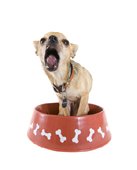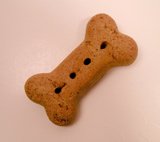 |
 | 
| |
Puppy Weight EstimatesPuppy Weaning at the Right TimePuppy weight estimates are important to determine age, and potential size; especially when you adopt a pup. New puppy care includes puppy weaning, crate training puppy and house training a puppy. When youre first looking at puppies, size can be deceptive. How can you figure out puppy weight estimates, not to mention overall size? You want to know this information before you adopt to make sure your new dog fits your home and lifestyle. Consider wanting a medium size dog - only to end up with a huge pooch? That can cause frustration and even possibly the need to return the dog or find it another home. Choosing Your Dog BreedAlong with puppy weight estimates and sizes, you also want to ask the breeder about the personality and energy levels of the breed youre considering. Big dogs with big tails and lots of energy can be very damaging to small homes. Unlike cats, dogs cant easily condense themselves. Big dogs also need different yard conditions (like taller fences). They will eat more, and can be harder to control due to sheer proportions. Puppy weight may change as you start puppy weaning and are initially uncertain as to how much food the dog should be given (most pups will be weaned no later than 7 weeks of age by the mother). Check with your vet to make sure that you are feeding the right amount of food (not too much, not too little). Training Your Puppy - Does Size Matter?When crate training puppy, youll need a crate suitable to the dogs anticipated growth and size. And when you're house training a puppy, you need to understand how much food and water (be careful of dog dehydration) you should be providing as it grows; this will impact weight and growth. One good way to get puppy weight estimates is by seeing the parents. In every litter there will be variations in birth sizes that often equate to which side of the family the puppy favors. The runt of the litter with a smallish mother often turns out small. Another good way to get some rough expectations is by reading a good guide to the breed of dog youre considering. The American Kennel Club and many other dog organizations offer excellent research information on which you can depend. The difference between pure and mixed breeds can be quite significant in terms of potential size. While shelters and pet shops do their best to identify the breed, you could really be looking at a surprise! If you fall head over heels in love with a mixed breed dog, there are a few things that may help you come up with puppy weight estimates with relative success. First, it may sound like an 'urban myth' but, just like humans, the size of a dogs paws do predict a lot. A big hulk of a dog cant walk on dainty feet! So tiny dog and big feet usually means LOTS of growth. Another good indicator of growth potential is loose skin. The looser it is, the more growth is likely to occur (but for dogs known for that characteristic). A few other age-dependent clues include:
Why is Estimating the Weight of Your Puppy as a Full Grown Dog Important?Trying to use puppy weight estimates to calculate how big your dog will grow is important (especially if you live in a small home or have size and weight restrictions in your condo or apartment), but it's much harder with mixed breeds than pure breed dogs. It's important to determine what size dog is best for your family, and then do you research and buying accordingly. Dont forget to review personality and temperament. This is particularly important in homes with young children or other pets. Take your time. This is a very important decision and you want both you and the puppy to be happy not just now, but for many years to come. New Puppy CareOnce you've decided on what breed and what puppy you want to bring home with you, you need to understand the basics of puppy care. Puppy weaning needs to occur before you can bring your new pup home. As soon as you get home you can start crate training puppy and house training a puppy. Don't expect instant success. Be patient and persistent and help your puppy learn. Bring your puppy to the veterinarian within a day or two of bringing her or him home. You want the vet to give your pup a full check-over and provide necessary vaccinations. Also talk to your vet about the best type of food to feed your dog: you want to ensure that you start your pup on a healthy dog food diet from the start; talk to your vet about your breed's susceptability for food allergies. If your pup develops food allergies, the symptoms may show up as skin conditions such as rashes or bumps. See your vet and work to find and eliminate the cause of the allergy (it is often related to wheat allergies or allergies to chemicals and fillers in commercially prepared foods; consider providing your dog with homemade dog food recipes and homemade dog treats). To relieve allergy symptoms, which can be itchy and uncomfortable, we recommend PetAlive Allergy Itch Ease. It temporarily relieves skin allergies and itch and has natural and herbal ingredients. Return to top of Puppy Weight Estimates. Return to The Dog Biscuit Home Page. | Related Articles
Each of these articles provides you with puppy information.
New Puppy Care Pet vaccines, neutering/spaying, check-ups, and more. How to Train a Puppy? Puppy training 101. House Training a Puppy Successfully training your new puppy - it's possible! Housebreaking a Puppy Your puppy needs to learn; housebreaking. Puppy Teeth: Dental Care Chewing and biting are normal symptoms of teething. Puppy Weight Estimates Are you able to estimate the potential weight of your pup at full growth? Puppy Worms: Treat Early Your pup's health is important; be aware of sick puppy symptoms and causes.       | ||
|
Enjoy This Site?
Then why not use the button below, to add us to your favorite bookmarking service? | |||
|
| Home | About
| Contact | Sitemap
| What's New
|Privacy Policy |
This site is for informational purposes only. If you have an issue with your dog's health, please see your vet.
Website design by Webmidwife.com | |||
| | |||







